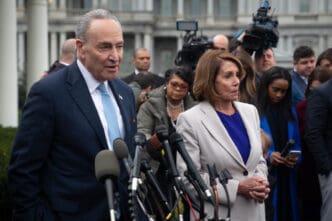Executive Summary
The Story So Far
Why This Matters
Who Thinks What?
The upcoming gubernatorial elections in New Jersey and Virginia, scheduled for November, are poised to serve as a critical barometer for the national political landscape, particularly regarding the enduring influence of President Donald Trump. Analysts are closely watching whether the outcomes will be shaped more by Trump’s ability to mobilize working-class racial minorities or by the Republican Party’s continued struggles in white-collar suburbs. Democratic nominees Mikie Sherrill in New Jersey and Abigail Spanberger in Virginia currently hold polling advantages over their Republican counterparts, Jack Ciattarelli and Winsome Earle-Sears, respectively.
Trump’s Influence on Local Races
Four years prior, Republican candidates in both states benefited from President Trump’s electoral strengths, notably an improved vote share among working-class racial minorities, while mitigating the impact of his vulnerability in white-collar suburbs. This year, however, the dynamic appears to be reversed, with Democrats holding consistent leads in recent polls.
Republican nominees Ciattarelli in New Jersey and Earle-Sears in Virginia face an uphill battle to activate the low-propensity voters, often younger and nonwhite, whom Trump mobilized in previous elections. Strategists question whether these are exclusively Trump voters or broader Republican supporters. Conversely, the Republican candidates could experience larger deficits in affluent suburban areas like Fairfax County, Virginia, and Bergen County, New Jersey, compared to 2021, when President Trump was less visible in the political discourse.
Evolving Voter Trends
Historically, both New Jersey and Virginia have often elected governors from the party that lost the White House the preceding year, especially when the sitting president faces significant disapproval. This pattern has made these races early indicators of shifts in national political arguments and voter allegiances, prefiguring trends for subsequent midterm and presidential elections.
The 2017 gubernatorial races, amid President Trump’s first year in office, saw Democrats achieve resounding victories, largely driven by gains in white-collar suburbs. This momentum continued into the 2018 midterms and President Joe Biden’s 2020 presidential campaign, where he secured substantial margins in similar well-educated suburban areas.
However, the 2021 governor’s races presented a different picture. With President Trump out of office, Republicans regained ground among well-educated voters by emphasizing cultural issues such as crime, education, and “parents’ rights.” This recovery was somewhat blunted in the 2022 midterm elections by a significant backlash among well-educated voters against the Supreme Court’s decision to overturn national abortion rights.
By 2024, as concerns about inflation overshadowed abortion, the suburban trends observed in 2021 resurfaced. Vice President Kamala Harris did not match President Biden’s 2020 performance in several key well-educated suburban counties. Concurrently, President Trump improved his showing among minority voters, particularly those without a four-year college degree, a trend that began in 2020 and was further evident in the 2021 and 2024 elections in New Jersey and Virginia.
Current Campaign Strategies
The underlying political environment in New Jersey and Virginia has diverged somewhat this year. Virginia faces unique headwinds for Republicans due to federal workforce and contractor budget cuts, compounded by an ongoing government shutdown, which disproportionately impacts the state. New Jersey has not experienced a singular issue of this magnitude focusing discontent with the Trump administration.
Both Spanberger and Sherrill are centrist Democrats with national security backgrounds, who entered the House in the 2018 “blue wave.” They have conducted disciplined campaigns, prioritizing the cost of living. In contrast, their Republican opponents, Ciattarelli and Earle-Sears, have focused on wedge issues such as immigration enforcement, resistance to climate policies, and concerns over policies affecting transgender students.
Democrats express confidence that these Republican attacks are not resonating as strongly this year. They argue that President Trump’s administration is perceived as focusing on “retribution and revenge and culture wars” rather than economic concerns. Both Ciattarelli and Earle-Sears have aligned themselves closely with President Trump, a stark contrast to the 2021 races where Republican candidates maintained some distance. This strategy, while aimed at mobilizing Trump’s base, has allowed Democrats to link them to a president with a 55% disapproval rating in recent state polls.
Outlook for November
The widespread discontent with President Trump provides Spanberger and Sherrill an opportunity to rebuild Democratic margins in white-collar suburbs, with recent polls showing them carrying a majority of white college graduates. While regaining ground with minority communities is less certain, political strategists suggest “buyer’s remorse” among some 2024 Latino Trump supporters, driven by high prices and deportation policies, could open a door for Democrats.
Local issues, such as a controversy surrounding Virginia’s Democratic Attorney General nominee and discontent with New Jersey’s outgoing Governor Phil Murphy over rising electricity costs, present localized challenges for Democrats. However, most analysts believe that the national current, which appears to be flowing away from President Trump, will largely dictate the outcomes. A Republican victory in either state would signal significant challenges for Democrats, while solid wins in both races would offer the first reliable indication of a potential Democratic wave in 2026.








